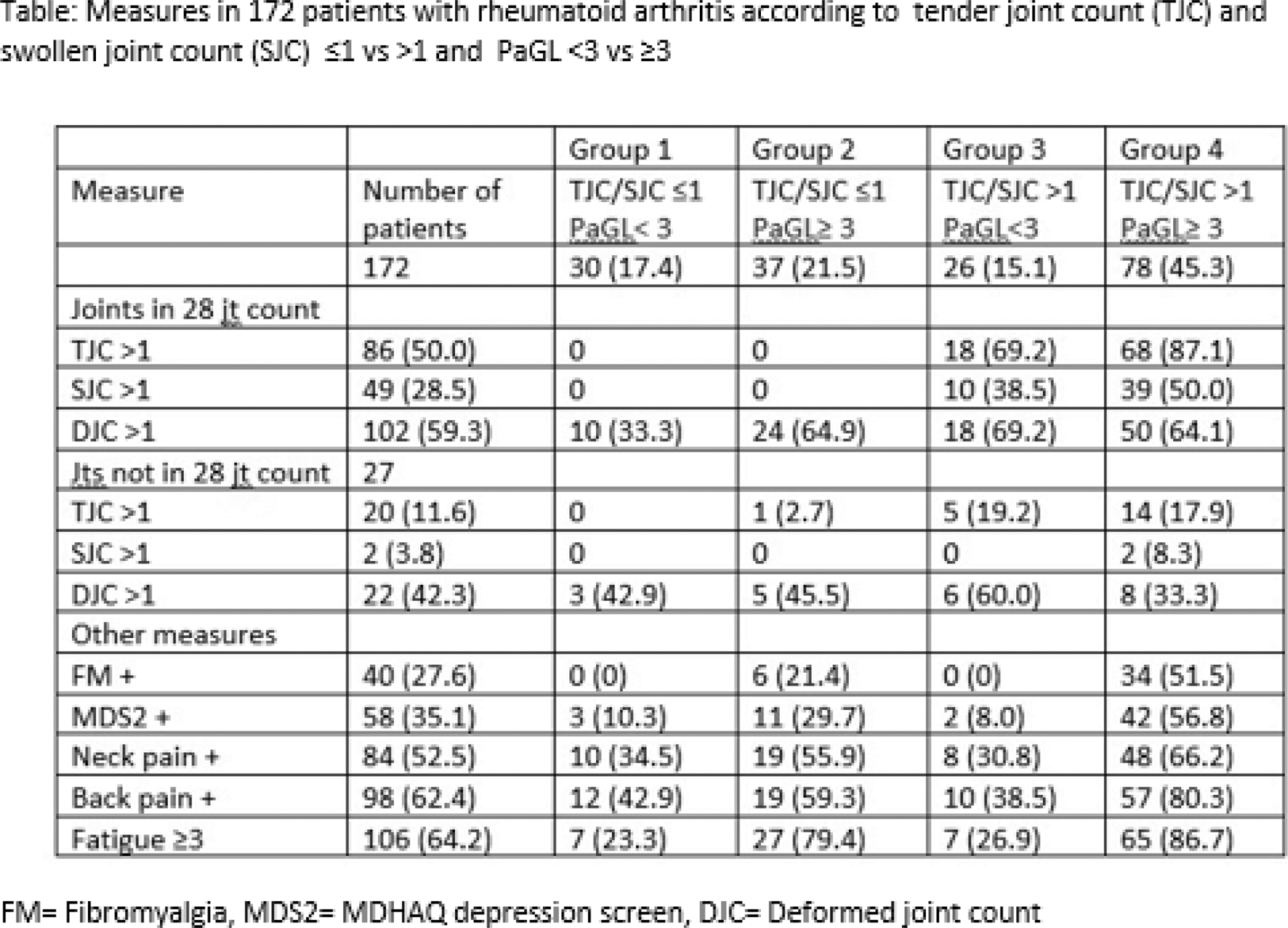

Background: Certain rheumatoid arthritis (RA) patients have a 28 joint count with 0 or 1 tender (TJC) or swollen (SJC) joints, but patient global assessment (PaGA) may be greater than 1 or even 3/10, thereby preventing RA remission criteria from being met. This observation has led to revision of PaGA Boolean RA remission criteria from 1/10-2/10. It is recognized that RA core dataset measures beyond PaGA, including tender (TJC), swollen (SJC) joint count and physician global assessment (PhGA) may also be elevated in the presence of little or no inflammatory activity, in RA patients with comorbid fibromyalgia (FM), depression (DEP), fatigue (FT), back pain (Bpain), neck pain (Npain), and/or joints with deformity/limited motion (DJC). One publication indicated that patients with TJC and SJC of 0 OR 1 and PaGA ≥3 reported pain in joints included in the RADAI (rheumatoid arthritis disease activity index) self-report painful joint count but not in the 28 joint count, suggesting that these patients may have inflammatory activity in these joints [1]. We examined other possible variables that may elevate PaGA in the absence of substantial inflammatory activity [2].
Objectives: To analyze RA patients who had 0 or 1 TJC or SJC, but PaGA greater than 3 according to possible variables which may raise PaGA in the absence of inflammation.
Methods: : A cross-sectional study of RA patients included collection of all 7 RA core dataset measures (SJC, TJC, ESR, PaGL, and PhGL, FN, pain). TJC, SJC, and deformed joint count (DJC) were assessed on a standard 28 joint count, and in 27 patients also were according to a 42 joint count which added 2 hips, 2 ankles and 10 MTP joints to the 28 joint count. RADAI painful joint count, FT, Npain, Bpain, and indices to screen for FM - FAST4 (fibromyalgia assessment screening tool), and DEP - MDS2 (MDHAQ depression screen), found on a 2-page MDHAQ (Multidimensional health assessment questionnaire), FAST4 and MDS2 agree more than 80% with reference standards (2). Patients were classified into 4 groups according to SJC 0 or 1 and PaGA ≥3, and into 2 groups for each possible noninflammatory variable, compared by chi square analyses.
Results: Among 172 patients, 30 had TJC/SJC ≤1 and PAGL <3, 37 had TJC/ SJC ≤1 and PAGL ≥3, 26 had TJC/SJC >1 and PAGL <3, and 78 had TJC/SJC >1 and PAGL ≥3 (Groups 1-4 table). DJC> 1 was found in 33-64% of patients. Among patients in Group 2, 21.4% were positive for FM, 29.7% for MDS2, 55.9% for Npain, 59.3% for Bpain and 79.4% for fatigue ≥3. These patients were comparable to group 4. Both groups were significantly different from patients in groups 1 and 3 in whim PAGL <3, regardless of TJC/SJC. Only 1 of 27 patients in Group 2 had one swollen or tender (MTP) joint, and all had at least 1 explanatory variable beyond other than joint count for their PAGL ≥3.
Conclusion: Several variables may elevate TJC, PaGA, PhGA and RA indices in the absence of inflammatory activity, including DJC, FM, DEP, Bpain, Npain and FT. Assessment of these variables may assist interpretation of PaGA and RA indices in clinical trials and clinical care.
REFERENCES: [1] RMD Open. 2022;8(2).
[2] Current Treatment Options in Rheumatology. 2021;7(3):161-81.

Acknowledgements: NIL.
Disclosure of Interests: None declared.